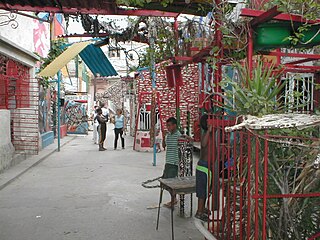
The following is an alphabetical list of topics related to the Argentina.

Cuban art is an exceptionally diverse cultural blend of African, South American, European, and North American elements, reflecting the diverse demographic makeup of the island. Cuban artists embraced European modernism, and the early part of the 20th century saw a growth in Cuban avant-garde movements, which were characterized by the mixing of modern artistic genres. Some of the more celebrated 20th-century Cuban artists include Amelia Peláez (1896–1968), best known for a series of mural projects, and painter Wifredo Lam, who created a highly personal version of modern primitivism. The Cuban-born painter Federico Beltran Masses (1885–1949), was renowned as a colorist whose seductive portrayals of women sometimes made overt references to the tropical settings of his childhood.

Víctor Manuel García Valdés was a Cuban painter. He was an early member of the "Vanguardia" movement of artists who, beginning in the 1920s, combined European concepts of Modern art with native Primitivism to create a distinctly Cuban aesthetic.

The National Museum of Fine Arts of Havana in Havana, Cuba is a museum of fine arts that exhibits Cuban art collections from the colonial times up to contemporary generations.

Juan Boza Sánchez or Juan Stopper Sanchez was a gay Afro-Cuban-American artist specializing at painting, drawing, engraving, installation and graphic design.
Humberto Castro is an important Cuban painter.

Manuel Rodulfo Tardo was a Cuban artist.
Esteban Guillermo Ayala Ferrer was a Cuban painter and a member of the Grupo Antillano.
Grupo Antillano was a Cuban artistic group was formed by 16 artists, between 1975 and 1985, in Havana, Cuba.
Roberto Juan Diago y Querol was a Cuban artist specializing in photography, engraving, painting and drawing.

Lesbia Claudina Vent Dumois is a contemporary Cuban visual artist, whose works include illustration, painting, art curation, and engraving. She does not specialize in any themes but is "interested in the everyday and historical references."
Juan Roberto Diago Durruthy"Diago" is a Cuban contemporary artist who graduated at the Escuela Nacional de Bellas Artes "San Alejandro," Havana. Grandson of artist Roberto Juan Diago Querol, his grandmother was a First Violinist in the Havana Symphony Orchestra. Born in an intellectual background, he nevertheless lived his childhood in a poor neighborhood, el barrio Pogolotti.

Leopoldo Romañach y Guillen (1862–1951) was a Cuban painter and educator.
The guitar was the first instrument that was heard in Cuba after the conch horns, flutes and drums that the original aborigines used to play; as it was documented by Spanish chroniclers such as Bernal Díaz del Castillo. Through the centuries, the guitar has continued to be one of the most important and cherished instruments in Cuba, both in the practice of popular music as well as in the classical music tradition. Founded by renowned professors such as Clara Romero, Isaac Nicola, Clara (Cuqui) Nicola, Carlos Molina, and Marta Cuervo Riverón, the Cuban guitar school has acquired an excellent international reputation since the 20th century, represented by important instrumentalists and composers such as Leo Brouwer, Carlos Molina, José Rey de la Torre, Juan Antonio Mercadal and Joaquín Clerch, among many others.
Roberto Donis was a Mexican painter and art teacher. He began studying art at the Escuela Nacional de Pintura, Escultura y Grabado "La Esmeralda", but unsatisfied with the instruction, helped organize a student strike. It was unsuccessful and rather than return to school, he decided to go to Morelia to teach. Donis’ art career consisted of exhibitions both in Mexico and abroad, including an important exhibition at the Museo de Arte Moderno in Mexico City and accepted as a regular with the prestigious Galería de Arte Mexicano. His teaching career included directorship at the Universidad Autónoma Benito Juárez as well as helping to found the Taller de Artes Plásticas Rufino Tamayo in the city of Oaxaca. He received several recognitions for his work, including membership in the Salón de la Plástica Mexicana.
Juan Esnard Heydrich was a Cuban sculptor. His career took off in the 1970s with the new regime of Fidel Castro, who commissioned several monuments on the revolution and personalities of Cuban history.

Jean-Baptiste Vermay (1786–1833) was a French-born Cuban painter, sculptor, caricaturist, educator, musician, and architect. He was the founding director of the Academia Nacional de Bellas Artes San Alejandro.
Pastor Argudín Pedroso, also known as Pastor Argudín Y Pedroso, was an Afro–Cuban portrait and genre painter, and teacher. He was internationally exhibited and was awarded the Order of Carlos Manuel de Céspedes by the Republic of Cuba, for his artistic merit.









